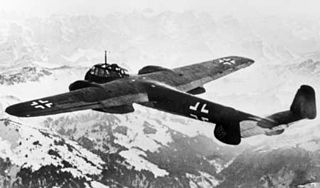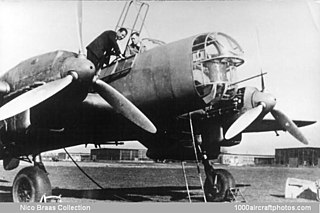
The Dornier Do 17 is a twin-engined light bomber produced by Dornier Flugzeugwerke for the German Luftwaffe during World War II. Designed in the early 1930s as a Schnellbomber intended to be fast enough to outrun opposing aircraft, the lightly built craft had a twin tail and "shoulder wing". Sometimes referred to as the Fliegender Bleistift, it was popular among its crews due to its handling, especially at low altitude, which made the Do 17 harder to hit than other German bombers.

The Dornier Do 215 was a light bomber, aerial reconnaissance aircraft and later a night fighter, produced by Dornier originally for export, but in the event most served in the Luftwaffe. Like its predecessor, the Dornier Do 17, it inherited the title "The Flying Pencil" because of its slim fuselage. The successor of the Do 215 was the Do 217.

The Dornier Do 335Pfeil (Arrow) is a heavy fighter built by Dornier for Germany during World War II. The Pfeil's performance was predicted to be better than other twin-engine designs due to its unique push-pull configuration and the lower aerodynamic drag of the in-line alignment of the two engines. It was Nazi Germany's fastest piston-engined aircraft of World War II. The Luftwaffe was desperate to get the design into operational use, but delays in engine deliveries meant that only a handful were delivered before the war ended.

The Messerschmitt Bf 110, often known unofficially as the Me 110, is a twin-engined Zerstörer, fighter-bomber, and night fighter (Nachtjäger) developed in Nazi Germany in the 1930s and used by the Luftwaffe during World War II. Hermann Göring was a proponent of the Bf 110, believing its heavy armament, speed, and range would make the Bf 110 the Luftwaffe’s premier offensive fighter. Early variants were armed with two MG FF 20 mm cannon, four 7.92 mm MG 17 machine guns, and one 7.92 mm MG 15 machine gun for defence. Development work on an improved type to replace the Bf 110 - the Messerschmitt Me 210 - began before the war started, but its shakedown troubles resulted in the Bf 110 soldiering on until the end of the war in various roles. Its intended replacements, the aforementioned Me 210 and the significantly improved Me 410 Hornisse, never fully replaced the Bf 110.

The Focke-Wulf Fw 187 Falke ("Falcon") was a German aircraft designed in 1935. It was conceived by Kurt Tank as a twin-engine, high-performance fighter, but the Luftwaffe saw no role for the design, perceiving it as intermediate between the Messerschmitt Bf 109 and Bf 110. Later prototypes were adapted to two-seats to compete with the Bf 110 in the heavy fighter (Zerstörer) role, but only nine aircraft were built in total.

The Heinkel He 177 Greif (Griffin) was a long-range heavy bomber flown by the Luftwaffe during World War II. The introduction of the He 177 to combat operations was significantly delayed, by both problems with the development of its engines and frequent changes to its intended role. Nevertheless, it was the only long-range, heavy bomber to become operational with the Luftwaffe during the war. The He 177 had a payload/range capability similar to that of four-engined heavy bombers used by the Allies in the European theatre.

The Dornier Do 217 was a bomber used by the German Luftwaffe during World War II as a more powerful development of the Dornier Do 17, known as the Fliegender Bleistift. Designed in 1937 and 1938 as a heavy bomber but not meant to be capable of the longer-range missions envisioned for the larger Heinkel He 177, the Do 217's design was refined during 1939 and production began in late 1940. It entered service in early 1941 and by the beginning of 1942 was available in significant numbers.

The Messerschmitt Me 264 was a long-range strategic bomber developed during World War II for the German Luftwaffe as its main strategic bomber. The design was later selected as Messerschmitt's competitor in the Reichsluftfahrtministerium's Amerikabomber programme, for a strategic bomber capable of attacking New York City from bases in France or the Azores.

The Junkers EF 61 was a German prototype twin-engined high-altitude bomber aircraft of the 1930s. Only two examples were built, but it provided valuable information on pressure cabins which aided the design of later pressurised aircraft.

The Junkers Ju 90 was a 40-seat, four-engine airliner developed for and used by Deutsche Luft Hansa shortly before World War II. It was based on the rejected Ju 89 bomber. During the war, the Luftwaffe pressed them into service as military transports.

The Henschel Hs 127 was a German bomber that was built as two prototypes, but cancelled without entering mass production.

The Jumo 211 was a German inverted V-12 aircraft engine, Junkers Motoren's primary aircraft engine of World War II. It was the direct competitor to the Daimler-Benz DB 601 and closely paralleled its development. While the Daimler-Benz engine was mostly used in single-engined and twin-engined fighters, the Jumo engine was primarily used in bombers such as Junkers' own Ju 87 and Ju 88, and Heinkel's H-series examples of the Heinkel He 111 medium bomber. It was the most-produced German aero engine of the war, with almost 70,000 examples completed.

The Daimler-Benz DB 601 was a German aircraft engine built during World War II. It was a liquid-cooled inverted V12, and powered the Messerschmitt Bf 109, Messerschmitt Bf 110, and many others. Approximately 19,000 601's were produced before it was replaced by the improved Daimler-Benz DB 605 in 1942.

The Focke-Wulf Fw 191 was a prototype German bomber of World War II, as the Focke-Wulf firm's entry for the Bomber B advanced medium bomber design competition. Two versions were intended to be produced, a twin-engine version using the Junkers Jumo 222 engine and a four-engine variant which was to have used the smaller Daimler-Benz DB 605 engine. The project was eventually abandoned due to technical difficulties with the engines.

The Heinkel He 118 was a prototype German monoplane dive bomber design that lost out to the Junkers Ju 87 Stuka in the 1930s, and was never ordered by the Luftwaffe.

The Daimler-Benz DB 600 was a German aircraft engine designed and built before World War II as part of a new generation of German engine technology. It was a liquid-cooled inverted V12 engine, and powered the Messerschmitt Bf 110 and Heinkel He 111 among others.

The Daimler-Benz DB 603 was a German aircraft engine used during World War II. It was a liquid-cooled 12-cylinder inverted V12 enlargement of the 33.9 Liter DB 601, which was in itself a development of the DB 600. Production of the DB 603 commenced in May 1942, and with a 44.5 liter displacement figure, was the largest displacement inverted V12 aviation engine to be produced and used in front line aircraft of the Third Reich during World War II.

The Messerschmitt Me 261 was a long-range reconnaissance aircraft designed in the late 1930s. It looked like an enlarged version of the Messerschmitt Bf 110. It was not put into production; just three Me 261s were built and used primarily for testing and development purposes.

The Messerschmitt Bf 161 was a 1930s prototype German reconnaissance aircraft.
The Dornier Do 417 was a twin-engine multirole combat aircraft. Developed in 1942, it resulted from the Luftwaffe's request for a medium bomber, a contest in which Dornier, Junkers, Heinkel, and Blohm & Voss competed. In the end, the Junkers Ju 188 was chosen by the Luftwaffe, and the Do 417 never entered production.



















